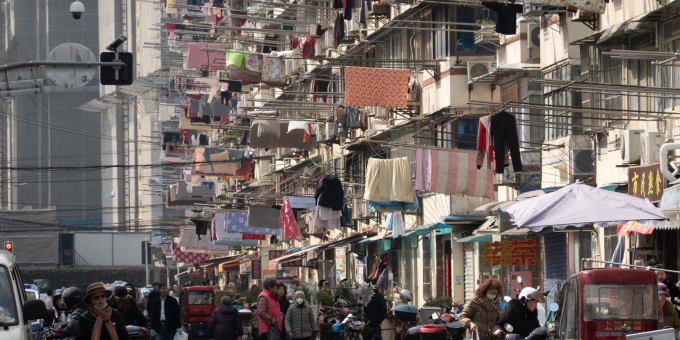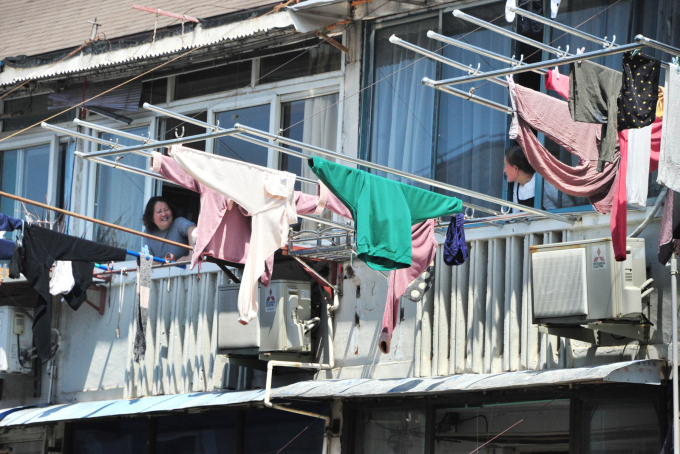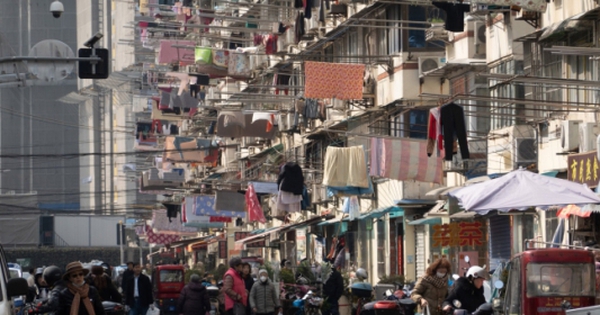The Unique Tradition of Hanging Clothes in Shanghai

When newcomers arrive in Shanghai, China, they may be surprised to see large clothes racks protruding from high-rise apartment buildings, especially in older residential communities. These racks are adorned with colorful clothes, blankets, and are playfully referred to by passersby as “flags fluttering in the wind.”
The design is remarkably simple: a fixed rectangular frame measuring about 3m x 2m extends from a balcony or window. Clothes are hung on long poles that provide ample exposure to sunlight and wind. Originally made of bamboo, the poles are now predominantly constructed from steel, and are long enough to dry three or four bedsheets simultaneously. For Shanghai residents, this method of drying clothes is even more effective than using a clothes dryer.
On a sunny day, the sight created by these racks can captivate passersby for a moment. However, privacy and modesty seem to have gradually disappeared, as clothes, including underwear, are fully exposed to the sun for all to see.
Strolling through the alleyways of Shanghai, one can easily spot these clothes racks, especially outside traditional houses and high-rise apartments built in the 1990s.
Prior to the 2010 Shanghai Expo, the city authorities frowned upon these common clothes racks, as they believed they ruined Shanghai’s image as a modern metropolis. The government decided to ban residents from hanging clothes outside windows along many major streets. However, some locals argued that this long-standing habit should be considered intangible cultural heritage.
It is worth noting that using these clothes racks can be quite challenging. The steel poles, ranging from 2 to 3 meters in length, can be extremely heavy when loaded with clothes, bedsheets, or even blankets. Residents must handle them with care, trying not to touch the dirty window ledge while maintaining their balance. One end of the pole should be held while the other is secured using a crescent-shaped metal hook on the frame to keep it in place.
Although it may seem secure, accidents have indeed occurred. In a residential area on Tham Xuan Street, Man Hang District, a clothes rack on the fourth floor of a building was blown away by strong winds, damaging the glass ceiling on the ground floor. Some individuals have also fallen from windows while attempting to stabilize the clothes rack. Consequently, certain communities have banned the use of these traditional designs.
The Desire for More Living Space in a Crowded City
Exactly when and where did these clothes racks first appear?
Despite numerous historical documents and local accounts, it is challenging to determine a definitive answer. According to Ma Shang Long, a writer in Shanghai, “The first people to start using these clothes racks were the workers.” He added that these racks may have initially appeared in a residential community built exclusively for workers in the 1980s and 1990s.
In Ma’s opinion, the appearance of these clothes racks in Shanghai can be attributed to necessity. “Firstly, the humidity in Shanghai is relatively high. Even when transitioning from living in alleyways to high-rise buildings, the people of Shanghai maintained the habit of hanging clothes outside. Secondly, living space in Shanghai has always been limited,” Ma said.
During the 1980s and 1990s, one-room apartments had an average area of only 13 to 15 square meters. When couples with children moved in with all their belongings, the room was almost entirely occupied. “As a result, many families came up with the idea of using their balconies to maximize their living space. However, as this left no room for hanging clothes, they resorted to hanging clothes racks outside their windows,” Ma explained.
Another writer from Shanghai, using the pen name “Co But Tau,” created a wooden clothes rack for drying clothes himself. He recalled, “In the 1980s, when hanging clothes racks became popular, they were all handmade by the residents. The prevalence of these racks is closely related to the sensitivity of Shanghai residents towards living space, or more directly, their craving for more living space.”
Chu Le Nguyen, who lived in an alley on Hoang Ha Street, Huangpu District during the 1980s, remembers the image that left the strongest impression on her: her mother-in-law competing for territory to hang clothes. Early in the morning, the petite yet assertive woman from Ningbo, a city in Zhejiang Province, rushed outside with seven or eight long bamboo poles to occupy all spots with sunlight in the alley. This often led to disputes among neighbors.
Nowadays, when she meets her old neighbors, they still tease her mother-in-law and praise her for being courageous.
Phan, who lives in an apartment building in Ting An District, says that the south-facing balcony and large clothes racks were the reasons she decided to buy her current apartment. “Nowadays, many new residential areas use compact drying racks (rather than traditional poles), but when fully extended, they only reach about 1 meter. This is not convenient for hanging laundry,” Phan explained.

The unique tradition of hanging clothes outside windows has become a distinctive feature of Shanghai’s architectural landscape. Despite the city’s efforts to eliminate this practice, many residents continue to preserve it for the convenience it offers. As a symbol of the city’s resilience and adaptability, these clothes racks remain an integral part of Shanghai’s cultural heritage.
For more information about finance and business, visit Business Today.

